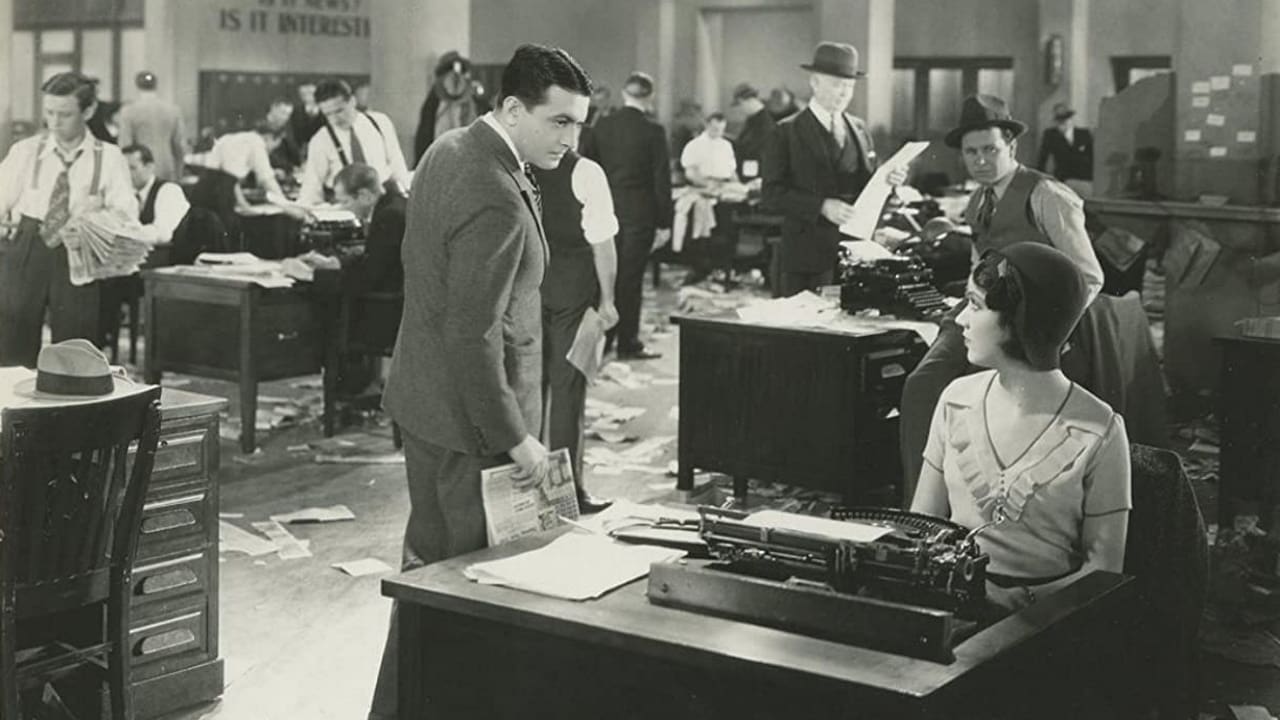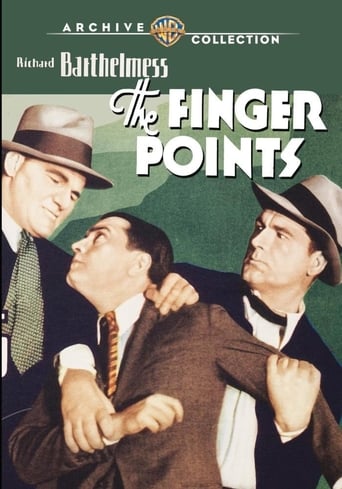

Contrary to what a lot of people say I think Richard Barthelemess's career was really boosted by the talkies - he was a real success story!! He had an inner spiritual quality noticed by D.W. Griffith and exploited in films like "Broken Blossoms" and "Tol'able David" and he gave beautiful performances. Even though, in "Weary River", an early talkie, he played a singing convict, it proved he could talk and his old sensitivity shone through. An added aloofness made him right at home as soldiers who come home from the war cynical and battered, all at sea in a world that has left them behind ("The Last Flight" (1931) and "Heroes For Sale" (1933)) and as a country hick who takes on the plantation owners ("The Cabin in the Cotton" (1932)). His popularity lasted for at least a few years and he was No. 6 in the popularity polls in 1931. "The Finger Points" is based on the career of Jake Lingle, a "leg man" - someone employed by a newspaper who goes from place to place looking for crime stories. He was initially hailed as a hero, after his death in 1931, but it was later revealed he was involved in racketeering with Al Capone. Talk about a movie "plucked from today's headlines"!!!Breckenridge Lee (Barthelemess) is an eager reporter from Savannah with a letter of recommendation to "The Press", the most prestigious newspaper in the city. At first he is pretty wet behind the ears but with the help of Marcia (could Fay Wray look any more beautiful) and Breezy (the always dependable Regis Toomey) he manages to get through without making too big a dill of himself. When "The Press" declares war on crime Lee becomes a crusader and is given an assignment to investigate "The Sphinx Club", a gambling house that is a front for the mob. Lee approaches it with gusto but Marcia and Breezy are horrified that such a "baby" should be given such a dangerous assignment as his first story.Unlike the other reporters who treat the crusading as a joke his zealousness gets "The Sphinx Club" raided and sees him beaten up by two thugs. He has already been offered a bribe by Haines' offsider Louie (Clark Gable) and of course he refuses, but when his medical bills come in and the paper refuses to help out it looks as though he will turn traitor!!! 1931 was an astonishing year for Clark Gable - he appeared in 12 features, from a basic walk on as Anita Page's righteous husband in "The Easiest Way" to the rough gangster who got to shove Norma Shearer around in "A Free Soul". As Photoplay commented at the time - "He's everybody's big moment"!! "The Finger Points" was definitely a high point for him!!Lee soon has the gangsters running scared with his threats of exposing them unless they do things his way. The "No. 1" - a faceless gangster, seen only from the back has given Lee $100,000 to keep his newest gambling house "The Waverley" out of the newspapers but - you guessed it, Breezy, who has been given a pep talk by Marcia about working hard and trying to amount to someone, has heard a rumor and is eager to expose "The Waverley" and all it's crookedness on the front page!!The movie ends on an ambiguous note - the nation mourns Lee as a martyr and Breezy gives one of those sentimental speeches about what a square guy Lee was and how he wouldn't be on the take etc, however, the gangsters think they know better, as Louie spits in disgust "A Martyr"!!! Even though Marcia doesn't want to have anything to do with him, once Lee gives her the old "I'm not working with them - I'm trying to expose them" speech she is quite happy to forgive and forget and doesn't insist he gives all his ill gotten gains to the local orphanage!!!
... View MoreAfter talkies came in, Warner Brothers didn't really seem to know what to do with Richard Barthelmess, but he hung around in starring roles quite a bit longer than most of his silent counterparts - from 1929 to 1934.Normally Barthelmess played thoughtful guys put into tight circumstances, and this was probably supposed to be one of those roles, but it doesn't' quite come across right. Breckenridge Lee (Richard Barthelmess) starts out as a totally green and conscientious reporter up from a Savannah paper into a press room of the big city. When the editor announces a campaign against the mob, Lee is the only reporter that takes his assignment seriously. He even walks right up to a speakeasy and asks probing questions to the mobster in charge. Unable to be bribed he writes an expose on the place and it is thus raided by the police. The mob then beats him up one night in retaliation, badly enough that he needs hospitalization and his medical bills pile up. He is surprised when the city editor balks at helping him financially, as he denies that Lee's beating had anything to do with the paper at all and hints that Lee's injuries probably had something to do with him drinking and hanging around unsavory people after work.Now this is where things get a bit unrealistic. Lee instantly turns from green honest reporter to money hungry and corrupt. He figures if you can't beat them, join them. He takes money from the mob and in return agrees to keep the paper and thus the cops off of their backs. He justifies this by saying that the only way that the mob will ever pay is with money to him - but he's not exactly giving the loot away to charity.Fay Wray plays Lee's love interest as fellow reporter Marcia who at first suspects then knows the truth and loves him just the same. Regis Toomey plays a supporting role as someone who would like to win Marcia's heart but knows when he's beat. Robert Elliot is the gruff tough city editor who often played a cop in the early talkies. Of course, most notable here is Clark Gable, sitting in the palm of Jack Warner's hand, and not being recognized by him as a star in the making. Gable is impressive here as a spats-wearing charming sinner, the gangster who sees Lee as a useful idiot - for awhile anyways.
... View MoreI looked at this movie mainly because of the leading man. I never saw him in a talkie before. He was no worse then most silent actors who came into talkies. He plays a new reporter from the south working at a big city paper. I must tell you I was not prepared for what was to come. And I am not going to spoil it. But he was such a fresh nice face that I actually thought in the end we would find out he was working undercover for the cops. But no he is mad because the newspaper would not give him a raise or advance his salary because he had gotten shot doing a story for them and he feels they should help with the Medical bills. So he becomes a reporter for the syndicate. He gets paid well for not writing stories. The problem is that his girlfriend, who also is working at the paper as a Ann Landers type columnist wants nothing to do with what he has become. I am not going to tell the ending. But I was surprised. Afterwards I found out this was based on a true story. The supporting cast was very good. I never realized how pretty Fay Wray was. She is striking. She always had a pretty face to me, but she is gorgeous. She is the girlfriend. She has a nice role. You can tell this was pre code because she had a good job and she was fairly aggressive about her feelings toward him. Regis Toomey was very good as a fellow reporter and best friend who also likes the Fay Wray character. But he a very nice guy and we do not get the usual rivalry that turns nasty. Which is good. Clark Gable was at the point of of his career when he played bad guys. Like in Night Nurse where he was smacking around old ladies and his girlfriend and trying to poison her children. He is not any nicer here. I actually like Gable in these roles. I would recommend this movies because it goes in a different direction that I thought and it was very nice seeing actors in the crossroads of their careers.
... View MoreI love movies which give you a sense of what it was like to be living & working in the time. (It's the sociologist in me. ) This movie is one of these. The plot is very interesting and the acting is first rate all round. Fay Wray is very good, but Richard Barthelmess steals the show and not just in the "silent" parts. Never seen him better.
... View More